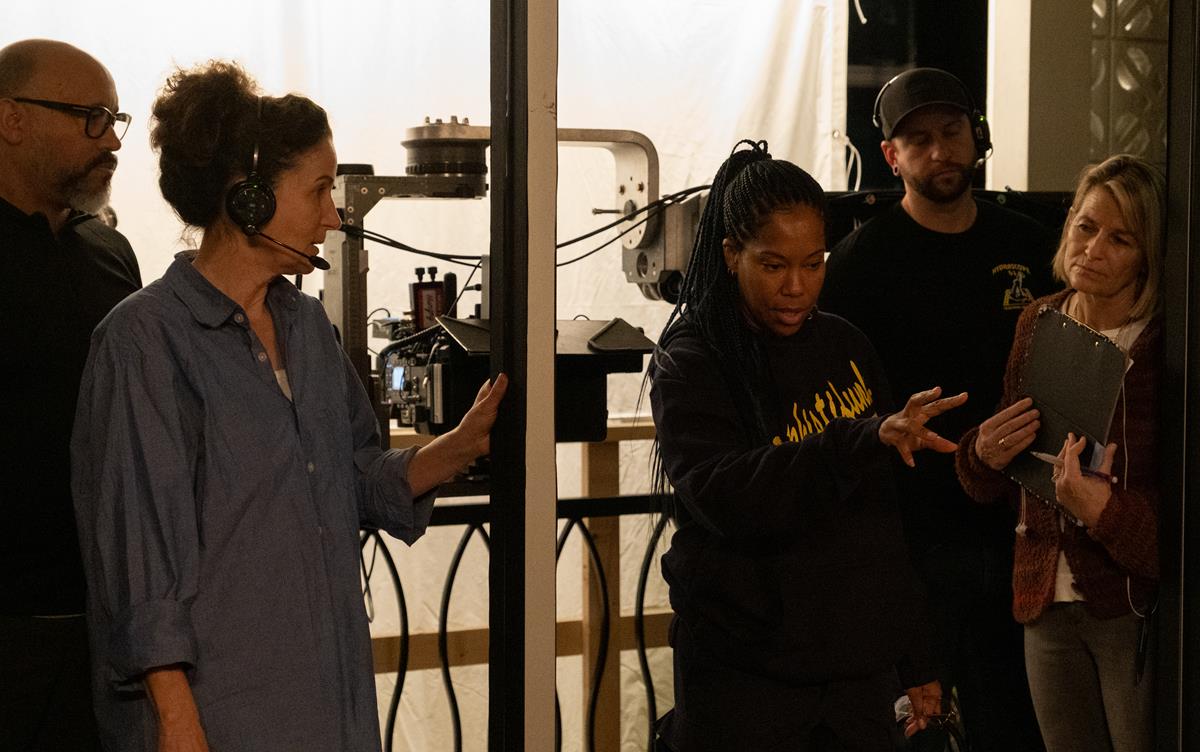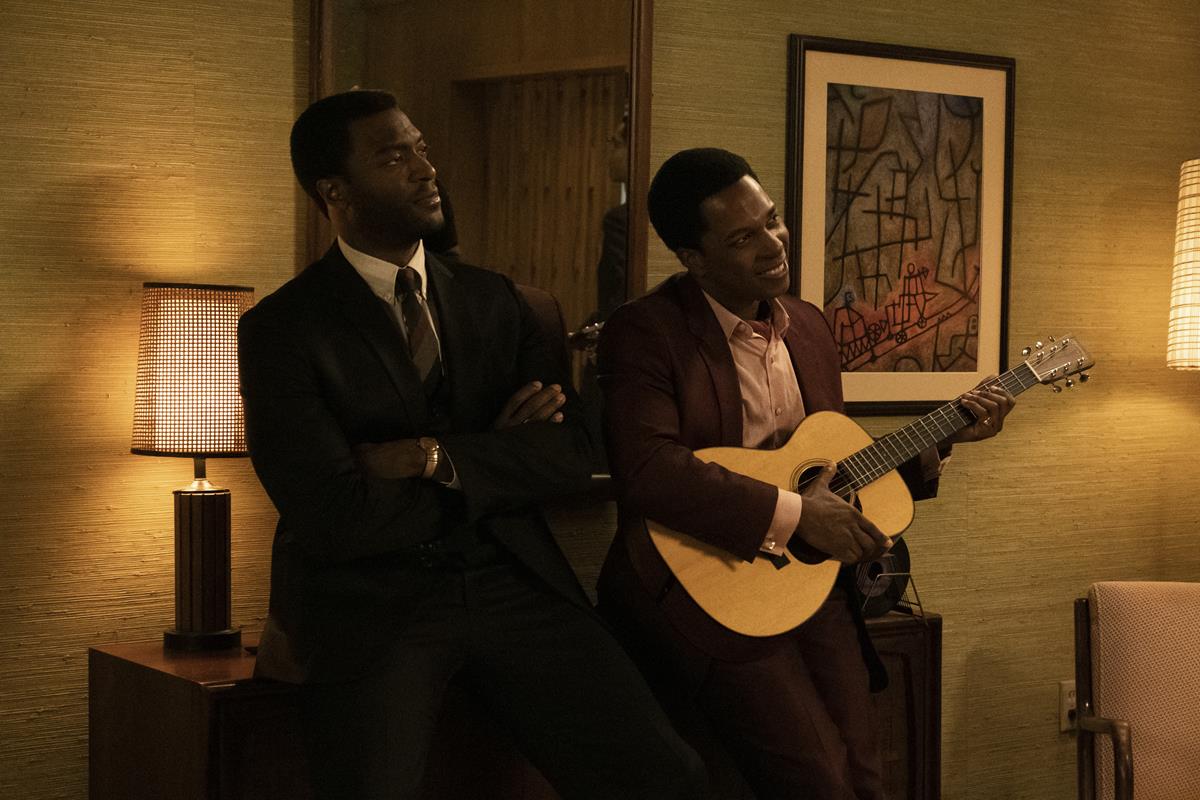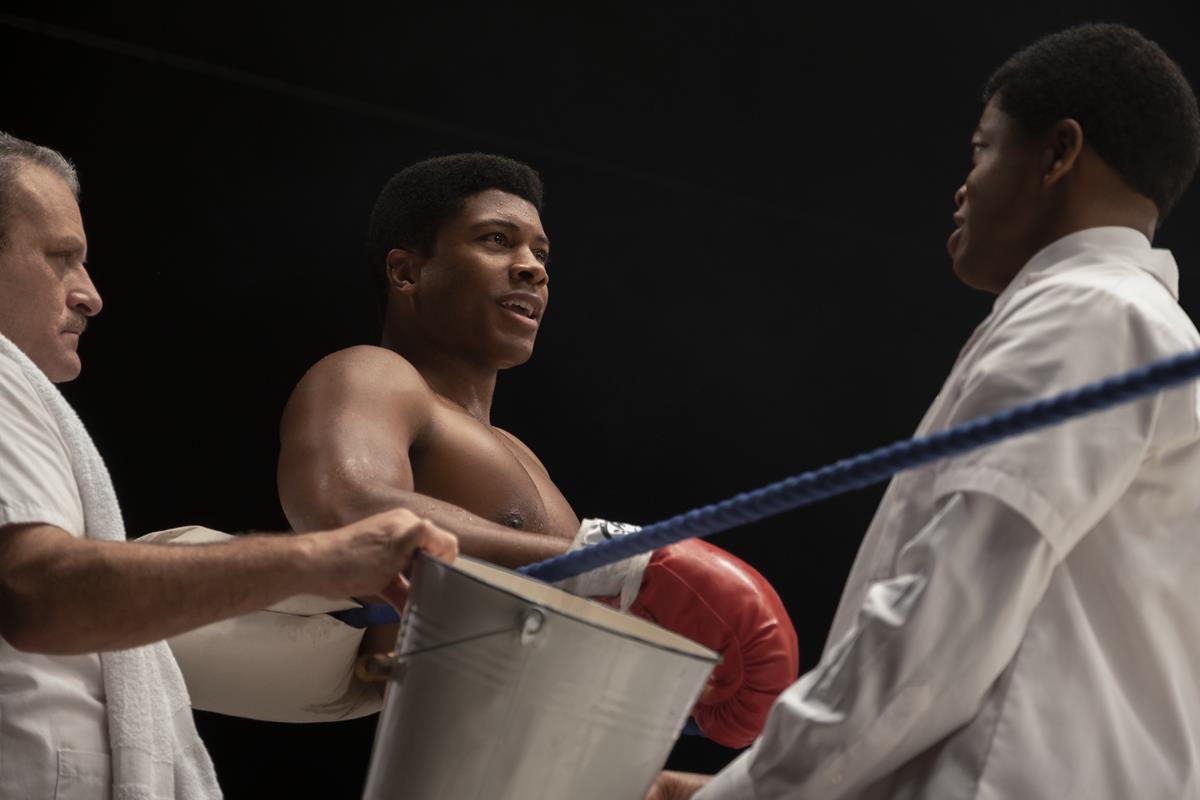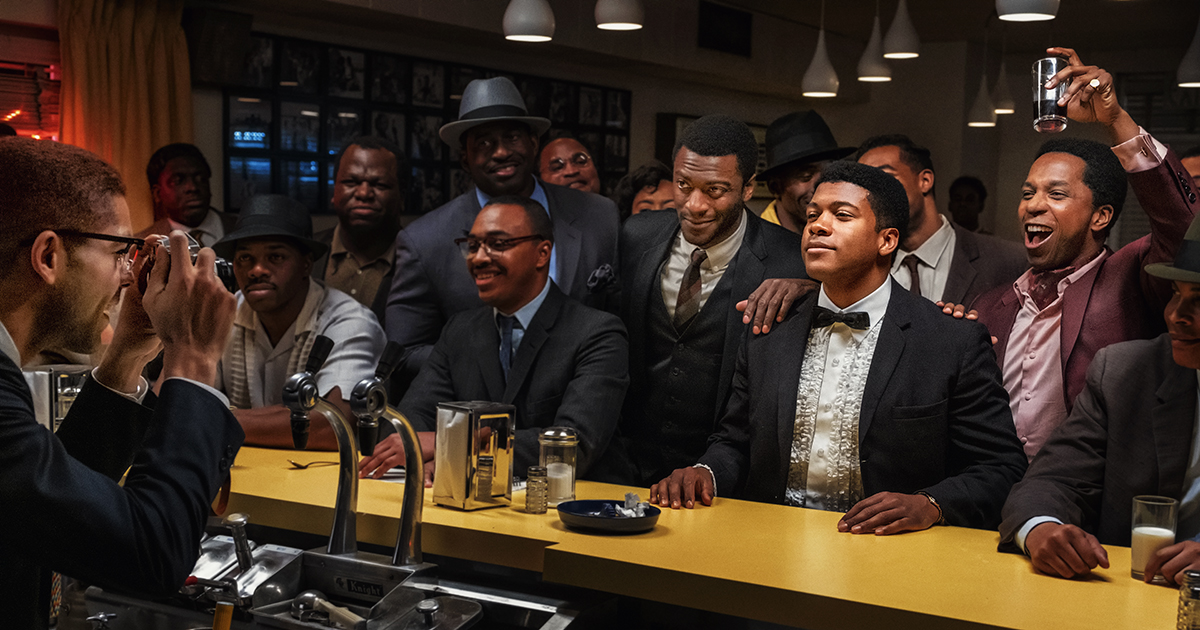On the evening of February 25, 1964, four icons of sports, entertainment and activism celebrated one of the greatest upsets in boxing history in a modest motel room in Miami. After claiming the World Heavyweight title for the first time, Cassius Clay (Eli Goree) — who would soon change his name to Muhammad Ali — got together with three friends: human rights activist Malcolm X (Kingsley Ben-Adir), music superstar Sam Cooke (Leslie Odom Jr.) and football legend and emerging action-movie hero Jim Brown (Aldis Hodge).
Set on the precipice of the momentous political and cultural upheaval of the 1960s, One Night In Miami… is a fictional imagining of the historic night these towering figures spent together. Unbeknownst to the others, Malcolm X, who is about to embark on a bold new undertaking that will put him in grave personal danger, has arranged the gathering in the hope of winning Clay’s support. As the evening progresses in surprising ways, the four men engage in passionate debate about their roles as celebrities and leaders at a pivotal moment in the Civil Rights movement.
Available now on Amazon Prime, One Night In Miami… is the feature directorial debut of actor and producer Regina King. The script, which is written by Kemp Powers, is based on his award-winning play of the same name. The film was shot by director of photography Tami Reiker, ASC, the first — and only — female cinematographer to win a competition-category ASC award for her work on HBO’s Carnivàle, in 2004. Her other feature credits include Craig Gillespie’s Mr. Woodcock, Peter Hedges’ Pieces of April, Peter Ho-Sun Chan’s The Love Letter, and Lisa Cholodenko’s High Art, which earned Reiker a Best Cinematography nomination at the 1998 Independent Spirit Awards.
Reiker is also known for her work on Gina Prince-Bythewood’s supernatural action movie The Old Guard, one of the most-viewed movies ever on Netflix, and both films were shot using the Arri Alexa 65 large-format camera, she notes in an interview with Leslie Combemale for The Credits:
“Using the Alexa 65 on The Old Guard, I just totally fell in love with the large format and suggested to Regina that it would be incredible for this film. She had used the Alexa 65 on If Beale Street Could Talk, and that was also a small film. I knew it wasn’t in our budget, but I went to [Arri Rental] here in Los Angeles, and presented my case, and gave them my script and Regina came by to visit, and they were amazing. They worked with us to make it so we could afford it.”

To help achieve the overall look of One Night in Miami…, Reiker tells Combemale, Arri Prime DNA lenses were selected for their softness:
“With the large format, you just have so much more information. The center is three times the size of the Alexa Mini. The fall-off for the Prime DNA, when you shoot wide open, you have a much more shallow depth of field, so it all just presents a creamier, more film-like look. We also shot with the Bronze Glimmerglass #1 filter, which added to the softness. You always have to take away that video edge. I am a huge fan of shooting digitally. I love it, but you do always have to fight that sharp edge it gives you. I had used a Glimmerglass on The Old Guard, but I’d never used a Bronze, which was beautiful. It was beautiful on the men’s skin. It just had this incredible warmth to it. That glow, that warmth of the movie, it’s the lighting, the wardrobe, and the makeup, but it’s also that Bronze Glimmerglass. It made a huge difference.”
READ MORE: “One Night In Miami…” DP Tami Reiker on Regina King’s Stunning Directorial Debut (The Credits)

With much of the film’s action taking place in a single room inside the historic Miami motel The Hampton House, the director was faced with the challenge of maintaining a sense of visual vitality. “It starts with great performances and great dialogue,” says King. “I definitely went into this feeling that the dialogue is the star and I never veered away from that. That said, I had countless conversations with my DP, Tami Reiker, about ways to help it not feel static.”
For King, that meant allowing the camera to move enough to create a sense of excitement but not so much that it distracted from the actors and what they are saying. “I always think it’s confusing as an audience member when you’re like, ‘What is the camera doing? Why is it moving?’”
To address King’s concerns, Reiker came up with the idea of shooting in the room with the Alexa 65 mounted on a jib arm, essentially a boom with a counterweight that allows the camera to move through an extended arc. “Some parts of the room, including the kitchenette, are actually cutouts,” says King. “We put the camera through those holes and the jib arm allowed us to always be kind of floating and created movement even when we weren’t moving.”
For lighting, Reiker primarily relied on Astera Titan Tubes, LED tubes that emit a “robust tunable light,” Brad Gullickson notes in his interview with the DP for Film School Rejects. “The Titan Tubes turned out to be our key,” she tells Gullickson. “These actors were so tall, they’re all over six feet and the ceiling was like eight and a half feet. We placed Titan Tubes in the corners and at different key places and we would watch the rehearsal. We always wanted to, as much as we could, keep them barely backlit and not just beaming.”
READ MORE: Cinematographer Tami Reiker Explains Why the Camera Floats in One Night in Miami… (Film School Rejects)

This lighting scheme was designed to help give the actors space to create their own movement, Reiker tells Stephen Saito in an interview for Moveable Feast:
“We wanted to give them the space to move around. And the hotel room, both cameras were on jib-arms that were manually operated by the operator so that they could drift with them. We had those jib-arms poking through every door and window. And wherever there was a painting or a mirror, there was a hole behind it that we could pop that off and shoot through there. We wanted to keep changing the perspective so that the camera could float from character to character, and then when they’re up on the roof, because they busted out of the room for a second, that was handheld so that we could then walk or pan from character to character, but giving them the freedom to move in that space. We shot very long takes, like 10, 12-minute takes, because the scenes were that long.”
READ MORE: Interview: Cinematographer Tami Reiker on Reading the Room in One Night in Miami… (Movable Feast)
Speaking to Patricia Thomson for American Cinematographer, Reiker further details the camera setup for the motel room:
“We wanted to keep the camera floating and drifting so we’d be constantly shifting perspectives. I presented this idea of keeping the camera on a jib arm but manually operated, not on a hothead. We had each 65 on a [J.L.] Fisher 10 dolly with a 12-foot jib arm and an underslung Cartoni Lambda head. [A-camera operator] Chad Chamberlain and [B-camera operator] Austin Alward could swing and drift and get to every corner of that hotel room. We could go from 2 feet to 10 feet in one move, and it was the operators making that decision, so it could be very organic.”
This approach, Reiker acknowledges, made lighting tricky, especially confounded by the room’s low ceilings. “We had to use very low-profile lights, mainly on the ceiling,” Reiker explains in her interview with Thompson:
“We used Astera Titan and Helios [LED] tubes with Honeycrates and fabric grids. They were rigged in all four corners of the room, and after we watched rehearsal, we’d decide which ones we’d use. For fill, we used a baby scoop light made by [gaffer] Allen Parks; it was a 10-inch metal disc with LiteGear bi-color LED cards and Magic Cloth diffusion over the top, and we added snoots and honeycomb grids. That allowed us to have a tight fill light on our actors without overpowering the set walls.” She gelled the Astera tubes with 1/4 CTO and dimmed the practicals, lamped with 40-watt tungsten bulbs, “to a nice warm hue.”
READ MORE: Tipping Point: One Night in Miami (American Cinematographer)

One Night In Miami… is anchored by two boxing matches: Clay v. Cooper in 1963, in which Clay suffered a knockout, and the renowned 1964 fight with Sonny Liston, where Clay claimed the World Heavyweight Champion title. Both sequences reference iconic photographs from the era to help establish the historical reality of the film.
“For the Clay-Liston fight, we used the “GOAT [The Greatest of All Time]” book [by Jeff Koons],” Reiker told Moveable Feast writer Steven Saito. “That’s such an incredible book, and we really used that to be really authentic and recreate the same lighting grid that they had used for that fight. There was also the overhead shot that actually wasn’t from the Clay-Liston fight — it was from a later fight, but we loved that image so much, we recreated that.”
“The bookends in the script are incredible,” Reiker said to Valentina Valentini in an interview for ICG Magazine. “The fight where Cooper knocks out Clay and then the celebration in the diner after Clay wins the fight against Liston. We knew how we were going to shoot those scenes. What we had to figure out was how to shoot inside one motel room, with very long takes, for most of the film.”

The main action of the film takes place inside The Hampton House, but Reiker and King also wanted to shoot some sequences outside at night without having to use a green screen, as she explains to Valentini:
“But every roof we scouted, the actors would have to have been on wires because of safety. Barry came up with this genius idea to build the roof on shipping containers right outside the sound stage. We were outside the city, so there was nothing around it, and we had 280 degrees of total darkness. I put little pinpoints of light all around — from a few hundred yards away to a quarter-mile away — to help recreate the Miami skyline, so you felt the life out there. VFX added buildings and fireworks in post.”
READ MORE: Tami Reiker, ASC, helps Director/Producer Regina King take One Night in Miami… from stage to screen (ICG Magazine)
Color grading and finishing services for One Night in Miami… were provided by post-production facility Light Iron in Los Angeles. A blog post on the Light Iron website details the collaboration between Reiker and supervising colorist Ian Vertovec, who performed the digital grade. The pair used stills graded during production by digital imaging technician Tyler Blackwell as a jumping-off point.
Working in Baselight, Vertovec rebuilt the LUT Reiker created for dailies in order to deliver versions tailored for multiple platforms. The rebuilt LUT was “based around getting the skin tones nice and rich, without too much red or too much green,” Vertovec recounts:
“Skin tones on the shadow side can often get ruddy, but we wanted more red in the mids, and then as it gets darker, we wanted it to get a little bit cleaner. Also, with highlights on skin tones, you sometimes get too much green, especially from yellowy lampshades or sconces. So we wanted to make sure we had a good balance of not too much green and not too much red, and for everything to render properly across all the different formats we had to deliver.”
Another critical aspect of the LUT was how it defined the roll-off through the shadows. “This film has a soft toe, where black is not all the way down,” Vertovec said. “There’s contrast, but it doesn’t have a crunchy black level. When it’s softer like that, you actually get less noise in the shadows, so you can get very dark without it feeling like you can’t see anything. Everything can still be very clean. I think that was a good choice for a movie that takes place largely at night.”
READ MORE: The Main Event (Light Iron)
Speaking with Matt Grobar for Deadline, Reiker discusses her early career, including her relationship with the late, great Harris Savides, the acclaimed cinematographer known for Gus Van Sant’s “young death” trilogy — Gerry, Elephant and Last Days — and David Fincher’s Zodiac, as well as how she landed her first big break with High Art. “People still, on set, will come up and be like, ‘I love that movie. That’s the reason I got into movies,’” she notes in the interview.
“Now more than 30 years into her career, Reiker remains inspired by all of the same things that led her to become a cinematographer in the first place,” Grobar writes. “I love my job because I love telling stories, visually,” Reiker concludes. “I love creating images, and light, and production design and costumes, beautiful things. I also love traveling and adventure.”
Want more? Head over to Deadline.com to watch Reiker’s video interview as part of Deadline’s “Production Value” video series.


